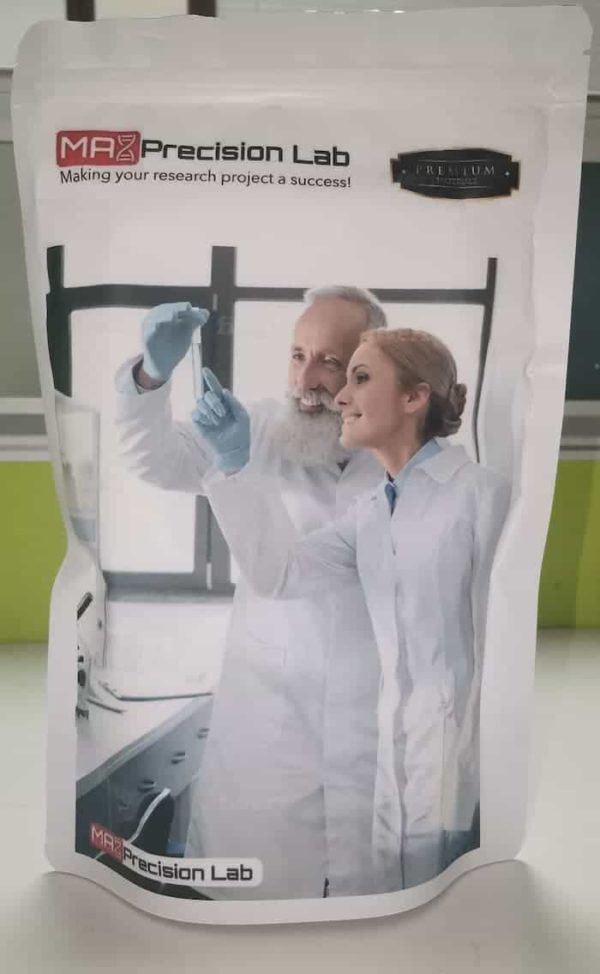MaxExtraction Stool Genomic DNA Isolation Kit (Columns)
|
Kit Information |
|
|
Reference number in the catalog |
A99 |
|
Content per package |
50T/100T |
|
Storage |
One year at room temperatura (15°C–25°C) in a dry area |
Kit Contents:
-
Components
A99-50T
A99-100T
RNase A
1 ml
1 ml × 2
Proteinase K
1 ml
1 ml × 2
Solution SA
40 ml
80 ml
Solution SB
20 ml
40 ml
Solution SC
30 ml
60 ml
Washing Buffer
15 ml
15 ml × 2
Elution Buffer
15 ml
30 ml
Filter Column
50 Units
100 Units
Adsorption Column
50 Units
100 Units
Collection Tube
50 Units
100 Units
Instruction
1 Piece
1 Piece
Note: Solution SA, SB, and SC should be stored at 2 to 8°C after opening.
Proteinase K and RNase A should be stored at -20°C.
Description:
The MaxExtraction Stool Genomic DNA Isolation Kit is appropriate for removing microbial DNA from stools. To the greatest extent possible, this kit effectively lyses several bacteria and fungus found in faeces. The extracted DNA has a high yield and good integrity, making it suitable for use in a wide range of regular procedures such Southern blots, PCR, enzyme digestion, and library creation.
Protocol:
Before used, add freshly opened absolute ethanol to the washing buffer; the volume should be calculated using the bottle’s label as a guide. Cap the bottle again and give it a good shake. At 2 to 8°C, the entire centrifuge process is carried out.
-
Add 400–800µL of Solution SA to a 50–200 mg stool sample and place on ice for 10 minutes. 1 minute of centrifuging at 12000 rpm.
-
Throw away the supernatant. To the precipitation, add 400µL ml of Solution SB, 20µL of RNase A (10 mg/ml), and 20 ml of Proteinase K (10 mg/ml), and whisk for 30 seconds. For 30 to 60 minutes, incubate in a 65°C water bath. Several times during incubating, invert the tube. Centrifuge at 12.000 rpm for 2 minutes.
-
Add 300-600µL of Solution SC to the supernatant in a 1.5 ml centrifuge tube. Centrifuge for 1-2 minutes at 12000 rpm. Place one Filter Column in a collection tube, then fill it with supernatant. Centrifuge for 1-2 minutes at 12000 rpm.
-
Transfer filtrate to an adsorption column and let stand there for a minute or two. For 0.5–1 minutes, centrifuge at 12000 rpm. You just need to do this step once.
-
Empty the collection tube of waste liquid and add 500µL of washing buffer to the adsorption column. 1 minute of centrifuging at 12000 rpm. You just need to do this step once.
-
Remove the waste liquid from the collection tube and re-insert the adsorption column. For 0.5–1 minutes, centrifuge at 12000 rpm.
-
Remove the Adsorption Column and allow it to dry for a short time at room temperature (time is different because of season, climate and other factors).
-
Place the Adsorption Column in a fresh centrifuge tube and add 50 to 100µL of the 65°C preheated Washing Buffer. 1 minute of centrifuging at 12000 rpm.
-
After adding the liquid to the adsorption column in step 8, centrifuge it for 1 minute at 12000 rpm. Microbial DNA solution for stools is the liquid in the centrifuge tube.
Notes:
-
-
First of all, fresh stool samples will offer higher performance. Also, it is important to refer to the ideal preservation circumstances for various samples.
-
If a solution has precipitated, heat and dissolve it in a water bath at 37 °C until it is clear; the result won’t be affected.
-
Precipitation should not be consumed along with supernatant because doing so will clog the adsorption column and reduce product quality.
-
-
-
The Elution Buffer’s volume shouldn’t be less than 50µL; doing so will reduce the effectiveness of the recovery process. Elution with water also results in some product loss, hence it is advised to use the elution buffer included in the package. In case of degradation, the DNA product should be preserved at
-
-20°C and should not undergo repeated freezing and thawing.
-
-
Reagents in liquid form should not be touched; if they are accidentally touched, rinse thoroughly with water.
-

